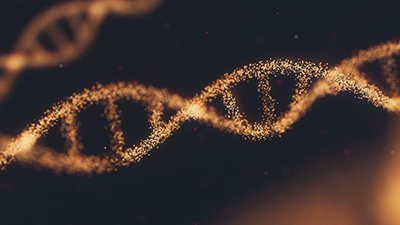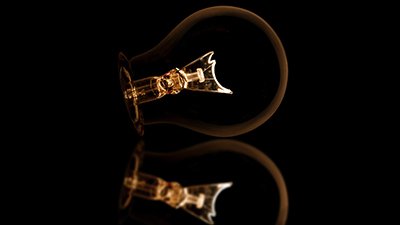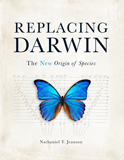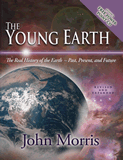
When Evolutionists Help Creationists Make Their Case, Part 2
Evolutionist Caught in Misconduct Doubles Down on Professional Misbehavior
Why do so many professional scientists (i.e., around 98% of PhDs1) accept evolution and reject young-earth creation (YEC)? I have observed that most scientists are not exposed to YEC science due to the legal restrictions in the US educational system.2 Therefore, their rejection of YEC becomes almost meaningless. How can someone deny an idea that they’ve never engaged?
I also showed, with examples, that when a small minority of mainstream scientists are exposed to technical YEC claims, “they appear to prefer ignorance of the key scientific details.”3
In extreme cases, a far more troubling explanation applies.
Professional Misconduct
I recently documented a shocking case of professional misconduct.
I recently documented an example of this—a shocking case of professional misconduct. In an attempt to counter the claims of YECs, the authors of a peer-reviewed journal article4 deliberately misrepresented the views of YECs—and then used the misrepresentation as evidence that YECs agree with their critiques. I documented this in video5 format and in print.6
Furthermore, the violators of this professional code happened to be leading anti-YEC voices—people like Joel Duff and David MacMillan. They are the ones to whom other prominent evolutionists turn when they desire rebuttals to YEC literature.7
One of the individuals (MacMillan) involved in this misconduct has responded in print8 to our initial video report—and has made the original problem worse. (MacMillan’s article was linked on Duff’s Facebook page.)
Tellingly, MacMillan doesn’t directly address the misdeed until far into his article. When he does, he adds to his initial dishonesty:
Jeanson accused Joel Duff and me of “scientific misconduct” because we quoted one of his papers without giving his proposed mechanism for this hyper-rapid evolution the attention he thinks it deserves.9
As the video10 shows, I did not accuse them of misconduct because I felt slighted by inattention. Rather, I documented that they engaged in misconduct by deliberately attributing to me the opposite of the position to which I hold—and then using this misrepresentation as “evidence” in favor of their point.
For example, see the direct quotes from their paper:11
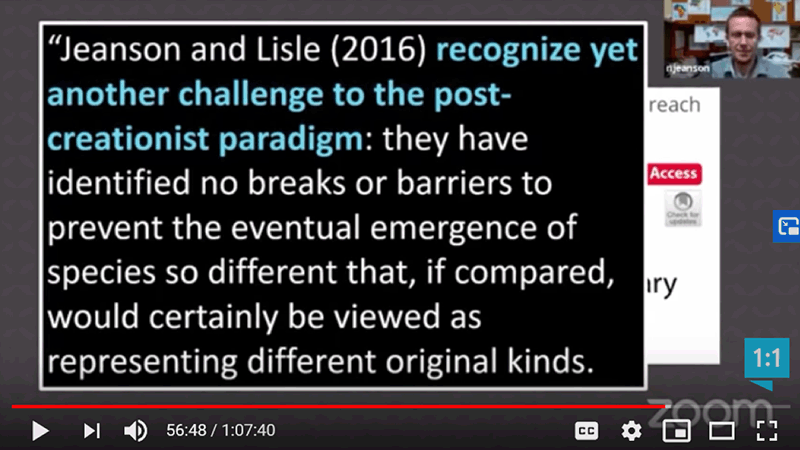
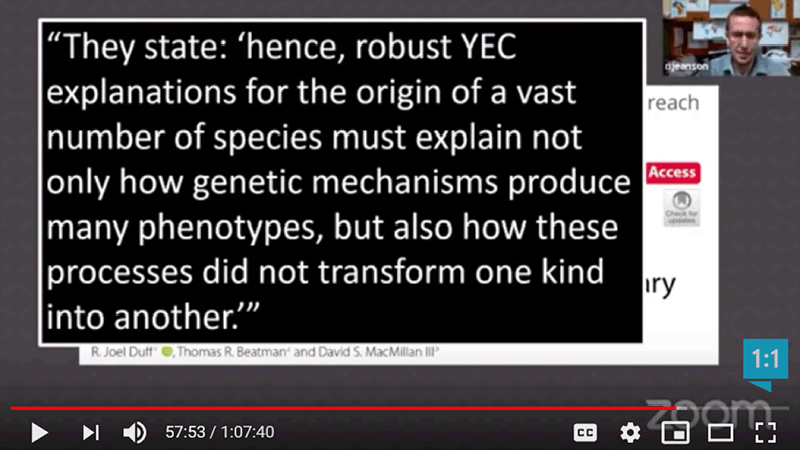
The latter quote (within the larger quote from Duff and colleagues’ paper12), which they attributed to Jeanson and Lisle, is from a paper13 that I co-authored with another YEC, Jason Lisle. It comes from the “Introduction” section of our paper—the early part of the paper that sets up the research question to be solved. What Duff, MacMillan, and colleague left out was the position that we stated at the end of the paper.
In the video, I gave several examples of this position, which we articulated repeatedly at the end of our paper:

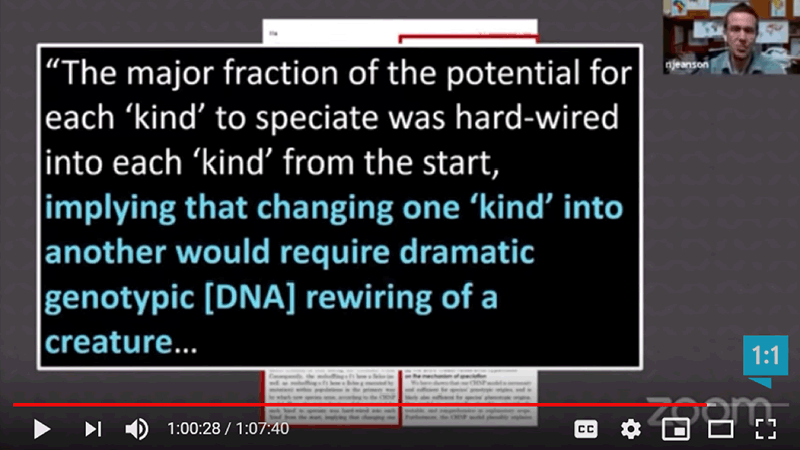
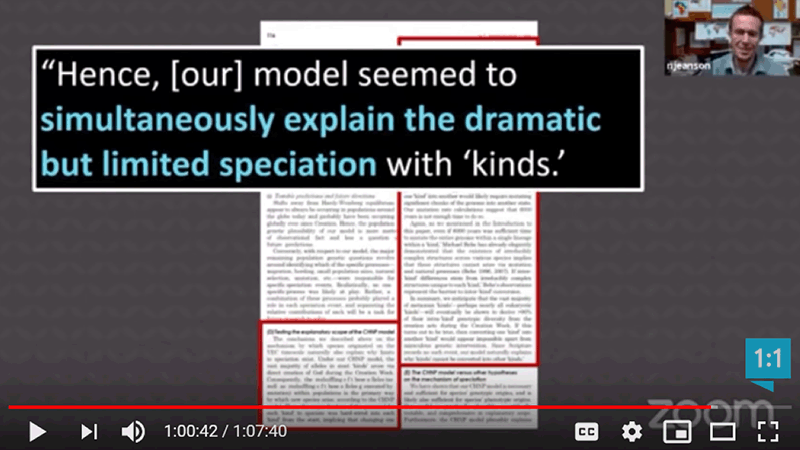
It’s very difficult to read Lisle’s and my paper and still miss these major points.
Past history of our interactions suggests that they were fully aware of these major points—and still chose to misrepresent them.
Past history of our interactions suggests that they were fully aware of these major points—and still chose to misrepresent them. As I showed in the video, this recent exchange between Duff et al. and me was not the first of our interactions over this specific 2016 Jeanson and Lisle paper.14 Four years ago, MacMillan and I directly engaged over the specific contents of the same paper. Thus, the authors cannot claim ignorance of its contents. Rather, they must have deliberately misrepresented our position—and then used it to claim that we admit to a purportedly unsolved problem in YEC.
Sadly, MacMillan’s written follow-up simply confirms the dishonesty of their initial action. Rather than acknowledge his initial error, correct it, and resume the discussion of the science, MacMillan doubles his instances of dishonesty. Instead of admitting to his initial misrepresentation, he adds another—misrepresenting my statements about his initial misrepresentation of our paper.
Given the prominence of MacMillan and Duff in the field of anti-YEC literature, it’s hard to overstate the significance of MacMillan’s professional misbehavior.
A Revealing Pattern
Why would MacMillan double down on his misconduct—and add to it? The rest of MacMillan’s written rebuttal reveals a troubling answer.
Before ever addressing the main point in question—the misrepresentation of my position—MacMillan weaves a wandering tall tale. He invents a narrative, and then twists our exchange in the context of this invented narrative, apparently in hopes that the narrative will make the additional dishonesty more plausible.
For example, MacMillan begins his rebuttal by addressing my four-year-old explanation for why evolutionists reject YEC science. But MacMillan doesn’t engage my position directly. This time, he doesn’t even try to quote me. Rather, he makes up a story:
Jeanson’s primary objection to our paper is not really any different to objections he made to a blog post I wrote four years ago, one he references heavily in his video. The objection actually bears a striking similarity to those I once received from Jay Wile, another (but unaffiliated) PhD creationist. It goes something like this: “If you read certain specific research papers, you wouldn’t disagree with me. So since you disagree with me, you’re either ignorant of the research because you didn’t read it, or you did read it and you’re just dishonestly ignoring it!”15 [emphasis his]
Notice how MacMillan gives no documentation for his hypothetical quote. No documentation for Jay Wile’s statement is given, and no links to my printed objections are given. MacMillan cleverly invents a position, and then implies that his caricature is representative of my views.
Rather than engage my actual views, MacMillan sidesteps them, preferring a rhetorical battle with a position that he’s invented.
If you read my original article16 from four years ago, you’ll find that my explanation doesn’t match what MacMillan implies. Reading his description of my position above, you’d think that people like me were closed-minded individuals, unable to grasp the possibility that people could rationally disagree. Instead, I’ve shown that mainstream education in the US systematically forbids exposure to all technical YEC literature. Rather than engage my actual views, MacMillan sidesteps them, preferring a rhetorical battle with a position that he’s invented. Rather than engage my points about the severe restrictions that the US educational system puts on developing scientists, MacMillan resorts to misrepresentations.
Why would MacMillan do this? Recall his response to my documentation of his misconduct:
Jeanson accused Joel Duff and me of “scientific misconduct” because we quoted one of his papers without giving his proposed mechanism for this hyper-rapid evolution the attention he thinks it deserves.17
Again, this misrepresents what I showed about their article. But it follows from the narrative that MacMillan has invented. MacMillan falsely claims that we respond to all evolutionists by digging for obscure published YEC facts, and then citing the obscure facts as “proof” that evolutionists are wrong. MacMillan claims that my objection did just that. This is a clear (but fictitious) example of the clear (but fictitious) narrative that MacMillan has created.
In other words, the story that MacMillan invents at the beginning of his article becomes the context into which he can place his repeated dishonesty about the misconduct in question.
The Tale Gets Taller
Having begun his engagement with a fanciful position, MacMillan then tries to rewrite actual history. In the video, I showed how, four years ago, MacMillan was caught in, at best, ignorance of my 2016 paper. At worst, he was fabricating information. In 2016, MacMillan quoted me, and then challenged my assertion:

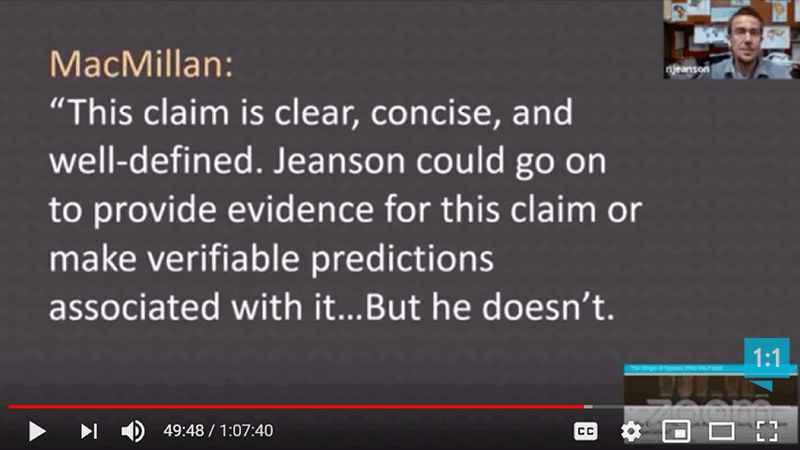
I showed how MacMillan appears to have never read the 2016 paper18 before trying to critique its claims. The direct rebuttal to his claim of the lack of testable predictions was found in the first paragraph of my 2016 paper. See the quote from the 2016 paper in the video screenshot below:
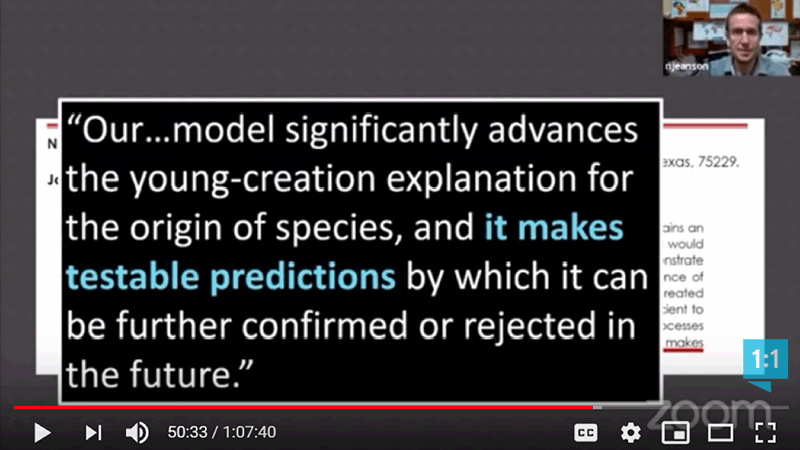
Again, this specific exchange about my supposed lack of testable predictions happened four years ago, and in 2016 I documented it in print.19 In my recent video20 (from which the screenshots above were taken), I simply reminded the viewers of this prior history.
In his recent written rebuttal, MacMillan tries to address this documented history—by rewriting it:
We did not address the entirety of every paper we cited (and I did not address his claims of testable predictions in 2016) because the claims are not valid. The “testable predictions” Jeanson asserts were not actually testable, not in the sense required by science. The mechanism he proposes for postcreationist hyper-evolution fails to solve the critical problem our paper identifies: namely, that the arguments they use to support their repeated consolidation of species into “kinds” work equally well to consolidate those “kinds” into even broader groups, as evidenced by our paper’s exploration of the gradual expansion of their purported “kind” boundaries.21
It seems that MacMillan hopes his readers won’t bother to check the very links he’s given.
It seems that MacMillan hopes his readers won’t bother to check the very links he’s given. For example, go ahead and click the link he supplied in his rebuttal. Do you see support for his claim that he “did not address [Jeanson’s] claims of testable predictions in 2016”? Or do you see the opposite? Again, in his 2016 article, MacMillan said:
Jeanson could go on to provide evidence for this claim or make verifiable predictions associated with it. For example, he could point to observed speciation events matching this model (if any existed), or he could predict a series of conditions under which a single pair of organisms can produce rapid multiple branching speciation in its offspring. But he doesn’t.”22 [emphases added]
Does MacMillan not read his own literature? He directly addressed my “claims of testable predictions in 2016.” But now he pretends this exchange didn’t happen.
Back in 2016, I charitably presumed that MacMillan hadn’t bothered to read what he was criticizing. Perhaps I was too kind. It seems that his dishonesty applies not only to my published work but also to his own.
Logical Incoherence
There’s another explanation for what I just wrote. It’s possible that I’ve just misread MacMillan’s recent rebuttal. After all, he says above that “The ‘testable predictions’ Jeanson asserts were not actually testable, not in the sense required by science.” [emphasis added] Is this what MacMillan actually meant in 2016, but never put in print? When he erroneously claimed in 2016 that I never made verifiable predictions, were we supposed to assume that he meant I never made verifiable predictions in the sense required by science?
Not only does this explanation strain credulity but it also collapses on itself into logical incoherence. Just look at MacMillan’s paragraph that I quoted above. Right after saying that my predictions weren’t testable, he immediately goes on to claim that my position has been scientifically refuted. In other words, MacMillan’s argument assumes that my claims are scientifically testable (which is a prerequisite for claiming that my proposals have been scientifically refuted). Which is it? Does he think my claims are not scientific because they are not scientifically testable? Or are they scientifically testable, and have been refuted?
This incoherence isn’t limited to MacMillan’s recent article. Our announcement of misconduct revolved around the paper23 he and his colleagues published in May. The entire premise of the peer-reviewed paper by MacMillan and co-authors is that my claims are scientifically testable and that they have been refuted. MacMillan appears to want to have the argument both ways.
In one sense, MacMillan’s error is not surprising. His logical contradiction is one embraced by many evolutionists.
In one sense, MacMillan’s error is not surprising. His logical contradiction is one embraced by many evolutionists. For example, when I was an undergraduate at the University of Wisconsin–Parkside, a philosophy professor from UW–Madison came to campus to give a lecture on the creation/evolution issue. He cited the two main objections to creationism—that (1) creationism wasn’t science because it wasn’t scientifically testable, and that (2) creationism had been tested and scientifically refuted. The professor chided his colleagues for this logically contradictory position, pointing out that both claims cannot be true at the same time. He concluded his lecture by adopting the first position—claiming that creationism isn’t science because it isn’t testable. Even opponents of YEC recognize the logical errors that frequent the arguments of their colleagues.
New Flights of Fancy
MacMillan then claims that I didn’t really understand what he and his colleagues were saying in the paper:
In his haste to accuse us of selective quotation and misrepresentation of his literature, Jeanson has unfortunately failed to grasp the essence of any of our objections.24
Recall that MacMillan and colleagues quoted the YEC literature to (erroneously) claim that we agreed with their objections.25 Now that I’ve documented their misrepresentation of our position, MacMillan suddenly reverses course and says that I don’t grasp the essence of any of their objections.
In a sense, this is a fitting response. Their misconduct revolves around misrepresenting the YEC position on the main point in question—whether creationists have grasped and answered the challenge of stopping speciation once they start it. And the paper that they misquote does exactly that—it states the challenge succinctly (as their quote of the paper shows), and then provides a solution. Yet MacMillan pulls out all the stops to avoid dealing with the solution. Why is he so resistant to engaging what creationists actually say?
To feel the weight of MacMillan’s dishonesty at this stage of our exchange, it’s helpful to recall the larger context of our interactions.
To feel the weight of MacMillan’s dishonesty at this stage of our exchange, it’s helpful to recall the larger context of our interactions. This is now the third public exchange he and I have had on a specific YEC paper26 that I (and another YEC colleague) published in 2016. Given this late state of our interaction, it is nearly impossible for anyone to assert that MacMillan is operating in a state of ignorance—that, despite three published articles about the 2016 YEC paper, MacMillan still doesn’t know what’s in the 2016 YEC paper. Instead, he appears to know exactly what’s in it, and he repeatedly refuses to honestly report what we’ve said—first stating that we hold to the opposite of our position, then claiming that we don’t understand a problem that we directly engage and to which we provide a solution.
Again, the issue at hand is not whether MacMillan and colleagues agree with our solution. (It’s quite clear that they have strong opinions about anything related to YEC!) The issue is whether they will honestly represent to their readers what we say. This is now the third instance where MacMillan flatly refuses, choosing instead to multiply his instances of dishonesty.
Fiction
Returning to MacMillan’s published rebuttal, his argument launches fully into what can generously be described as an alternate reality:
I coined the term postcreationism to describe the ever-moving goalpost represented in creationist literature between microevolution and macroevolution. Jeanson sets up a simple strawman at the outset, contrasting his view of biological origins against the species fixity taught by pre-Darwinian biologists. This suggests he did not pay close attention to the paper, which characterizes postcreationism not as a stark departure from nineteenth-century naturalism but as the culmination of a long creationist march toward accepting broader and broader evolutionary change. Creationism has undergone such a massive shift in allowable “microevolution” that we even propose educators use this in discussing biology with students. It may be embarrassing for creationists like Jeanson to admit this shift, but that is no reason to deflect and project.27 [emphasis his]
Did I not pay close attention to the paper? If you watch the video,28 you’ll see that I stated their position explicitly—even putting it on a slide:
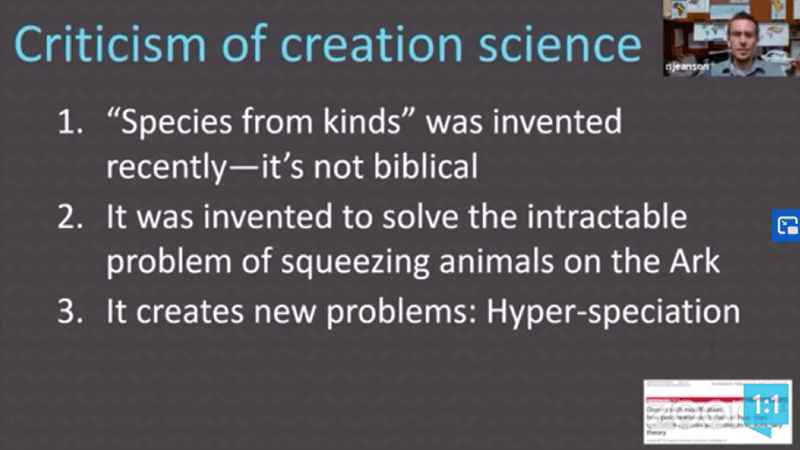
Notice the little screenshot of their paper29 in the corner. I’m describing to the listeners the essence of their position—that they claim that the YEC position (about new species forming within kinds) is a recent invention.
If you watch further along in the presentation, you’ll see that I explicitly engage their claims about the recent-ness of our position—and show evidence against it. For example, in the 1700s Linnaeus himself held to a concept of kinds remarkably similar to the current YEC position:

Therefore, in light of this evidence from Linnaeus, it is factually inaccurate to say that modern creationism is the “the culmination of a long creationist march toward accepting broader and broader evolutionary change.”
MacMillan is free to list the reasons why he thinks this evidence is irrelevant to his main claim. He’s welcome to engage the data and supply a counter-argument. But he doesn’t. Instead, he erroneously claims that I set “up a simple strawman at the outset,” and that I “did not pay close attention to the paper, which characterizes postcreationism not as a stark departure from nineteenth-century naturalism but as the culmination of a long creationist march toward accepting broader and broader evolutionary change.”
Did MacMillan watch the video? Is he pretending to be familiar with content that he hasn’t viewed? Or is he deliberately misrepresenting what I explicitly said?
MacMillan doesn’t make this dishonest claim just once. In his article, he repeats it:
One reason Jeanson makes a sympathetic opponent is that he grasps the opposing side’s viewpoint well and takes pains to articulate it. A large portion of his presentation comprised slide after slide of hundreds of ruminant species, some surprisingly bizarre, to illustrate the broad diversity of life on Earth. He did this, he said, to give his creationist audience a taste of why mainstream scientists view the creationist Ark story with extreme skepticism. Unfortunately, he fell short of explaining the underlying objections.
As our article explains, many of the earliest creationists denied speciation altogether, arguing instead that observable variation was a mere difference between breeds. Over time, however, they came to accept that “microevolution” could allow for a genus splitting into multiple species, and later a family splitting into multiple genera. More recently, postcreationists like Jeanson and his colleagues at Answers In Genesis speculated that microevolution could extend so far as to allow all the families, genera, and species in an entire order to have descended from a single common ancestor… Jeanson insists that this progression is not motivated by a lack of space onboard the Ark. But this deflection only makes things worse. If they aren’t trying to compress the number of ancestral progenitors on the Ark, then the only explanation is that they are following the evidence for common ancestry right up the evolutionary tree of life.30 [emphases added]
Did you catch what MacMillan just did? According to MacMillan, creationists like me are either trying to solve the supposed problem of fitting animals on the Ark or “following the evidence for common ancestry right up the evolutionary tree of life.” He refuses to acknowledge the third possibility that I explicitly stated in the video: That the creationist position on kinds long predates Darwin himself, which contradicts the main premise of MacMillan’s explanation. Again, this is ironic coming in the midst of paragraphs purporting to show how YECs have failed to grasp evolutionary objections to YEC.
Climax
Having multiplied his dishonesty, it’s at this stage of his article that MacMillan finally addresses the main basis for our accusations of misconduct:
Jeanson accused Joel Duff and me of “scientific misconduct” because we quoted one of his papers without giving his proposed mechanism for this hyper-rapid evolution the attention he thinks it deserves.31
In context of his tall tale, his misrepresentation fits his invented narrative. It’s fair to wonder whether MacMillan thinks that he is being not dishonest but genuinely honest—perhaps he truly believes the story that he’s concocted and thinks that he’s accurately reporting on his own tale.
MacMillan then descends into logical incoherence again:
In reality, of course, we simply did not have the time, space, or inclination to explain why his “testable predictions” are in fact wholly untestable or why his genetics model misses the mark. Such refutations have already been made by others in the scientific community.32
In other words, “It’s not testable, but here are the ways that it’s been tested and disproven.”
In his article, MacMillan supports the last sentence in the quote above with a link to a specific evolutionary blog33 that critiques my book Replacing Darwin.34 With regards to this specific blog that MacMillan cites as a source for “refutations,” it’s not clear why he picks this one. The author is not a PhD biologist but an evolutionary biology graduate student. This student has publicly admitted a lack of expertise35 on the key subject matter in my book. As a result, at least one theistic evolutionist, when confronted with student’s own admissions, has declined to defend the student’s blog.36
MacMillan then concludes his article by repeating his main point of objection to the YEC view of speciation:
More importantly, though, this newly-evolved brand of creationism has a bigger problem than the lack of a functional mechanism for allowing hyper-rapid evolution. Darwin had no understanding of DNA or genetics, yet he was still able to draw conclusions about ancestry from his observations of morphology and biogeography. Creationists have drawn similar conclusions about ancestry — first insisting that each species was a unique creation, then arguing that all species within each genus constitute a single kind, then raising “kind” to the level of the family or even the order. Why stop there? If they can accept that cattle, sheep, giraffes, and deer all evolved from a common ancestor, why not include horses, pigs, and rhinoceroses as well? What is stopping them from proposing a “caniform kind” including dogs, bears, badgers, and seals, or from simply proposing a “carnivoran kind” that adds cats, hyenas, and mongooses?37
The YEC answers to his questions havebeen published in the paper that MacMillan has repeatedly misrepresented.
The YEC answers to his questions have, of course, been published in the paper38 that MacMillan has repeatedly misrepresented. I’m sure he’d disagree with the answer. But this is a discussion for another day. The bigger issue is that MacMillan refuses to accurately represent what we’ve published. He’s free to disagree with our conclusions. But he cannot repeatedly lie about our position, and then call it science. It’s impossible to have a rational scientific discussion about a position that you refuse to accurately represent.
Again, it should be clear that none of this is a personal attack on David MacMillan or his colleagues. They have engaged in serious professional misconduct, which I have previously documented39 and which has been amplified by the dishonesty of MacMillan’s attempted rebuttal, as shown above. Professional misbehavior of this magnitude is not tolerated in other disciplines of science. The purpose of this article is to document the unchecked unprofessionalism that has persisted among the leading anti-YEC voices in the creation/evolution debate.
Dénouement
Why are people like MacMillan treated as the leading voices of opposition to YEC science? Why do leading theistic evolutionists cite the work of people like MacMillan and Joel Duff as authorities on the supposed problems with the YEC view of speciation? If this is how professing Christians justify their rejection of YEC science, imagine how the non-Christian world does it.
The mainstream opposition to YEC science might stand at 98% of professional scientists.40 Sadly, the (un)professional behavior of leading voices for anti-YEC science betrays the reasons why.
Footnotes
- Pew Research Center, “An Elaboration of AAAS Scientists’ Views,” July 23, 2015, https://www.pewresearch.org/science/2015/07/23/an-elaboration-of-aaas-scientists-views/.
- Nathaniel T. Jeanson, “Why Don’t More People Accept the Young-Earth View of Speciation?” in The Origin of Species After the Flood web series, Aug. 6, 2016, https://answersingenesis.org/natural-selection/speciation/why-dont-more-people-accept-the-young-earth-view-of-speciation/.
- Ibid.
- R. Joel Duff, Thomas R. Beatman & David S. MacMillan III, “Dissent with modification: how postcreationism’s claim of hyperrapid speciation opposes yet embraces evolutionary theory,” Evolution: Education and Outreach 13, no. 9 (2020), https://doi.org/10.1186/s12052-020-00124-w.
- Originally on Facebook, now found here: https://www.youtube.com/watch?v=UWqtVzOPOoU.
- Nathaniel T. Jeanson, “When Evolutionists Help Creationists Make Their Case: A Shocking New Case of Professional Criticism Gone Bad,” June 30, 2020, https://answersingenesis.org/theory-of-evolution/when-evolutionists-help-creationists-make-their-case/.
- See documentation in video (https://www.youtube.com/watch?v=UWqtVzOPOoU) and print (https://answersingenesis.org/theory-of-evolution/when-evolutionists-help-creationists-make-their-case/).
- David MacMillan, “Committing Scientific Misconduct,” June 21, 2020, https://medium.com/@davidstarlingm/committing-scientific-misconduct-b14579c1161a.
- Ibid.
- https://www.youtube.com/watch?v=UWqtVzOPOoU.
- Duff et al., “Postcreationism’s claim.”
- Ibid.
- Nathaniel T. Jeanson and Jason Lisle, “On the Origin of Eukaryotic Species’ Genotypic and Phenotypic Diversity: Genetic Clocks, Population Growth Curves, and Comparative Nuclear Genome Analyses Suggest Created Heterozygosity in Combination with Natural Processes as a Major Mechanism,” Answers Research Journal 9 (2016):81–122.
- Ibid.
- Ibid
- Jeanson, "More People."
- Ibid.
- Jeanson and Lisle, “On the Origin.”
- Jeanson, "More People."
- https://www.youtube.com/watch?v=UWqtVzOPOoU.
- Ibid.
- David MacMillan, “Creationists Evolve ‘New’ Arguments to Explain Genetic Diversity,” Panda’s Thumb (blog), August 2, 2016, http://pandasthumb.org/archives/2016/08/creationists-ev.html.
- Duff et al., “Postcreationism’s claim.”
- MacMillan, “Scientific Misconduct.”
- See documentation in video (https://www.youtube.com/watch?v=UWqtVzOPOoU) and recent web article (https://answersingenesis.org/theory-of-evolution/when-evolutionists-help-creationists-make-their-case/)
- Jeanson and Lisle, “On the Origin.”
- MacMillan, “Scientific Misconduct.”
- https://www.youtube.com/watch?v=UWqtVzOPOoU.
- Duff et al., “Postcreationism’s claim.”
- MacMillan, “Scientific Misconduct.”
- Ibid.
- Ibid.
- https://evograd.wordpress.com/.
- Nathaniel T. Jeanson, Replacing Darwin: The New Origin of Species (Green Forest, AR: Master Books, 2017).
- https://discourse.peacefulscience.org/t/icons-of-evograd/1584/7.
- https://discourse.peacefulscience.org/t/a-dialogue-with-nathaniel-jeanson/10935/26.
- MacMillan, “Scientific Misconduct.”
- Jeanson and Lisle, “On the Origin.”
- See recent video (https://www.youtube.com/watch?v=UWqtVzOPOoU) and web article (https://answersingenesis.org/theory-of-evolution/when-evolutionists-help-creationists-make-their-case/).
- Pew Research Center, “An Elaboration.”
Recommended Resources

Answers in Genesis is an apologetics ministry, dedicated to helping Christians defend their faith and proclaim the good news of Jesus Christ.
- Customer Service 800.778.3390
- © 2024 Answers in Genesis

